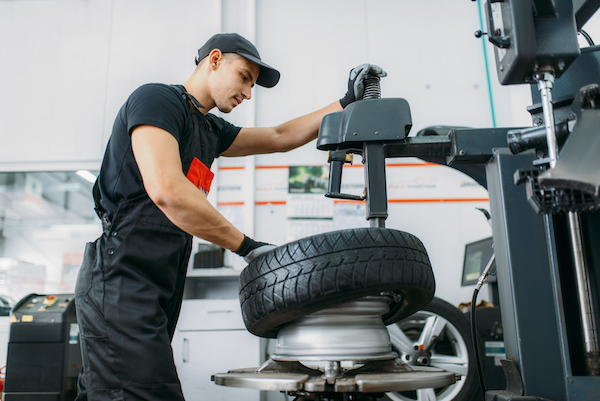Tire Solution: Comprehending Tire Pressure Monitoring Systems
Comprehending Tire Stress Tracking Equipments (TPMS) is a vital aspect of maintaining optimum car performance and safety and security on the roadway. With developments in vehicle modern technology, TPMS has come to be a common function in contemporary automobiles, supplying real-time information on tire pressure levels. Diving much deeper right into the ins and outs of TPMS, one can uncover the various parts that make up this system and the importance of each in guaranteeing precise surveillance. From direct to indirect TPMS systems, the landscape of tire pressure monitoring varies, each with its one-of-a-kind set of considerations and benefits. Stay tuned to unwind the intricacies of TPMS, from upkeep tips to the indisputable benefits of keeping your tires effectively blew up. discount tires morris il.

Importance of TPMS
The significance of Tire Stress Monitoring Systems (TPMS) lies in their capability to boost lorry security and efficiency through real-time tracking of tire stress levels. Preserving the appropriate tire pressure is important for making certain optimal handling, braking, and total security of a car. TPMS supplies motorists with instant comments on any kind of overinflated or underinflated tires, enabling prompt adjustments to be made.
Components of TPMS
Consisting of various necessary aspects, a Tire Pressure Surveillance System (TPMS) functions as an advanced security attribute in modern-day lorries. The main elements of a TPMS consist of sensors, a control component, and a caution indication. Sensors are normally located in the tire shutoff stem or connected to the wheel assembly, where they gauge tire stress and send data to the control module. The control component procedures this info and triggers a caution if it identifies considerably reduced stress in any of the tires. The caution sign, often an icon on the dashboard, informs the motorist to inspect the damaged tire or tires. Some advanced TPMS models also display the real tire stress analyses for each tire, giving vehicle drivers with real-time information to guarantee optimum tire performance and security. By checking tire stress continually, TPMS aids protect against mishaps, reduces tire wear, and enhances gas efficiency, making it a critical element for vehicle safety and security and efficiency.
Sorts Of TPMS

On the other hand, indirect TPMS depends on the automobile's wheel rate sensors to monitor tire pressure. This system detects underinflation by next page contrasting the rotational rates of the wheels. Indirect TPMS is less costly than direct TPMS, as it makes use of existing sensing units within the vehicle.
While straight TPMS supplies more precise readings, indirect TPMS is simpler in style and usually needs less maintenance. Both systems have their benefits and restrictions, and the choice between them commonly relies on variables such as price, car make, and individual choice. Understanding the differences between these two kinds of TPMS can aid lorry proprietors make notified decisions pertaining to tire upkeep and safety and security.
TPMS Upkeep Tips
Conduct regular checks on the tire stress degrees and contrast them with the TPMS analyses to guarantee they are regular. During tire turning or substitute, make certain that the TPMS parts are dealt with very carefully to avoid any prospective damages. If the TPMS cautioning light brightens on the dashboard, deal with the problem promptly by checking the tire stress and the total system for any kind of faults.
Advantages of Correct Tire Pressure
Maintaining correct tire pressure, as stressed in TPMS Maintenance Tips, is critical for enjoying the numerous advantages related to ideal tire pressure levels. One of the main benefits of maintaining the appropriate tire pressure is boosted fuel efficiency. When tires are appropriately pumped up, there is less moving resistance, causing much better gas economy. Furthermore, correct tire stress guarantees even tire wear, prolonging the life-span of the tires and promoting much safer driving problems. With the ideal tire pressure, vehicles likewise have better handling and grip, especially in negative climate condition. This can enhance general driving performance and safety for the chauffeur and travelers. Moreover, preserving optimum tire pressure can add to a smoother and more comfortable adventure by lowering vibrations and sound triggered by underinflated tires. In final thought, the advantages of appropriate tire pressure surpass just tire durability; they include boosted gas effectiveness, improved safety and security, better learn this here now automobile performance, and overall driving comfort.
Final Thought
Finally, recognizing tire pressure tracking systems (TPMS) is essential for keeping ideal tire pressure and making sure vehicle safety. By acknowledging the significance of TPMS, recognizing with its components, recognizing the various types offered, sticking to appropriate maintenance suggestions, and realizing the advantages of maintaining correct tire stress, chauffeurs can boost their driving experience and prolong the lifespan official source of their tires. Appropriate tire pressure is essential to risk-free and effective automobile procedure.
